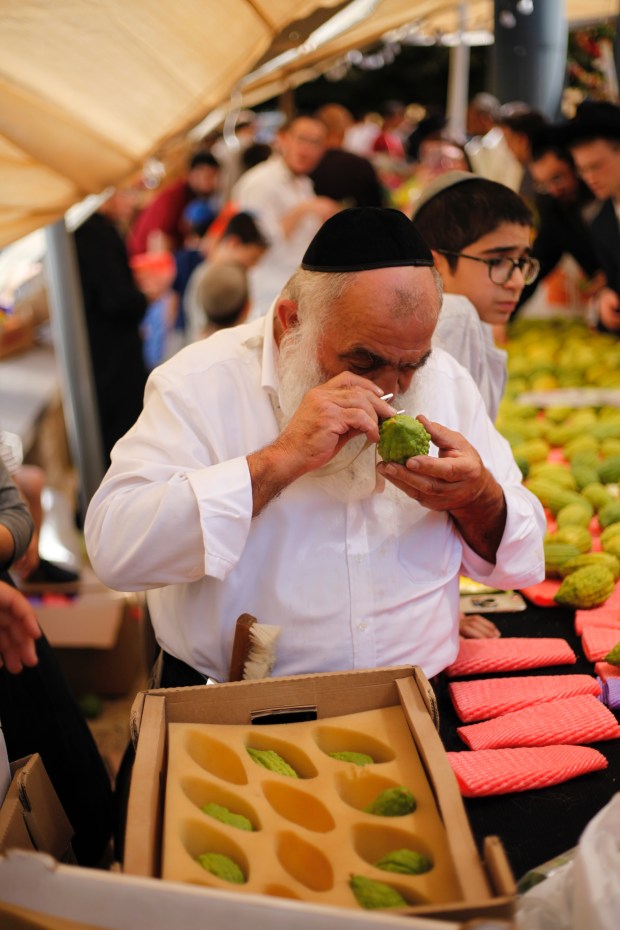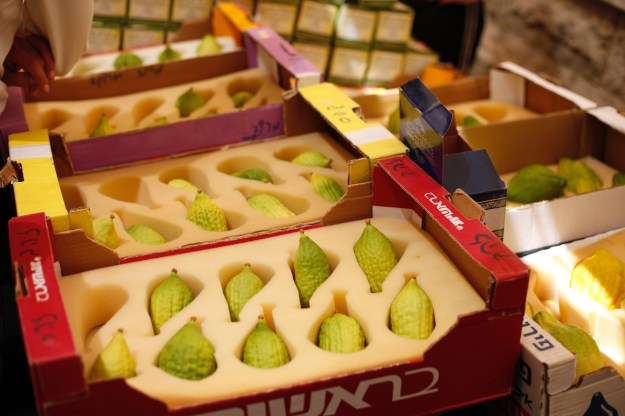Rabbi Moshe Adrai gingerly plucks a bumpy, lemon-like citrus from a table of dozens. If he so much as scratches the fruit’s glossy skin, its value will plummet from as much as $100 to nearly zero. He examines the citron, known as an etrog, with the careful eye of a diamond dealer and then swipes it with a brush as a line of Orthodox men wait around him to purchase the fruit before the Jerusalem sun sets.
“The etrog is like your heart,” the rabbi says when asked why he gives each citron a gentle brushstroke. “And your heart needs to be clean.”
Every September or October, Jewish communities around the world celebrate the agriculture-steeped holiday of Sukkot, during which Jews must bind together an etrog—a deliciously fragrant and mostly inedible citrus, also spelled ethrog or esrog—along with parts of three other plants, recite a prayer over them, and then shake the four items. But believers will not settle for any old citron; they want a fruit that is as pristine as a freshly minted coin, and for a few days each fall, the etrog is among the world’s most expensive fruits.
The long and winding path of this ancient fruit, from mere citrus to a powerful and expensive religious symbol, spans China, the mountains of Morocco, and Jewish communities of Eastern Europe. Its history is as complex as the elaborate Jewish customs and beliefs that have come to surround it. From powers of fertility to promises of prosperity, the etrog possesses near-mythical qualities among some believers, and many are willing to pay hundreds of dollars to fulfill God’s commandment to clutch it in their first.

The origins of the citron are in China, where it was considered commonplace among a plethora of citrus fruits, says Rabbi David Z. Moster, who recently wrote a book on the etrog’s ancient history. But as the plant made its way west, it gained exotic status, being used in Indian religious rituals and planted in the Persian empire’s illustrious royal gardens.
“At each stage of its travel, it went higher and higher into the human cultural esteem,” says Moster, who also directs the New York–based Institute of Biblical Culture.
Believed to be the first fruit to make to make the 4,000-mile east-to-west journey and the first yellow fruit the ancient Israelites had ever seen, the etrog was quickly adopted by the locals sometime after the Persians imported it around the fourth century BCE, says Moster. Jews came to see the aromatic citron as God’s chosen fruit for the Sukkot holiday to fulfill the biblical commandment to “take the product of goodly trees”; by the late Second Temple period, disgruntled Israelites were using the nearly rock-hard etrog to pelt their ruler, King Alexander Jannaeus, according to one first-century historian.
Jewish communities in the diaspora continued to cherish the etrog and spawned tracts of rabbinical arguments through medieval times on every aspect of the fruit. In Eastern Europe, entire villages are said to have pooled their money to buy just one of the rarefied etrogs, and customs developed touting its connection to childbirth. One especially popular tradition is to turn the pulp and thick rind into a jam that is said to help ease labor.
“Everyone looks for etrogs according to their customs,” says a schoolteacher who moonlights as an etrog seller in Jerusalem and identified himself as Yossi, 45. Etrogs come in various shapes and sizes, depending on the strain and where and how they were grown. Some rabbis want a citron with a narrowed belly, called a gartel, and others want it bumpy or relatively smooth, oblong or round, green or yellow. But there are some commonly accepted beauty standards: unblemished skin, total symmetry, and an unbroken pitom—the short stem that caps the fruit—unless the pitom shed naturally while still on the branch.
“You see this?” says Yossi as he points to an almost imperceptible dot on a yellow etrog from Morocco. “This is a problem.”


Nowadays before the weeklong Sukkot holiday, Jerusalem’s Orthodox neighborhoods erupt with boxes of citrons and piles of palm fronds, which masses of worshippers inspect and bargain over. In the makeshift Four Species Market, a canopy-covered swath of etrog-laden tables is surrounded by squished men looking for the perfect fruit. There are $300 etrogs enveloped in thick foam protectors and vendors selling the football-size citrons preferred by Jews of Yemeni descent.
The once-a-year economy for this impractical fruit functions because many are willing to pay premium prices for the most immaculate etrogs. The principle of mehudar (essentially, to go above the bare minimum of God’s commandment) forms the backbone of this economy. If you want an etrog mehudar, making the extra effort—usually meaning spending extra money—is a part of the deed.
This monied hunt for the perfect citron can lead to “an element of keeping up with the Joneses,” says David Wiseman, the owner of Zaide Reuven’s Esrog Farm, one of the few U.S. farms growing the fruit.
“There are people who can spend hours looking for every spot and every blemish, just like people who are buying a car could spend days,” he adds.
When you see something that is so pure, you see it with your own eyes, you don’t even begin to question it.
Today’s bustling etrog economy ensures that any people willing to pay at least $10 can have their own etrog. Israel is the largest supplier, but the fruit was largely planted there after the founding of the state in 1948, and many Jews swear by the older and supposedly unadulterated etrogs farmed in Calabria in southern Italy or those grown by Berbers in Morocco’s Atlas Mountains.
“When you see something that is so pure, you see it with your own eyes, you don’t even begin to question it,” says Tsvi Dahan, who travels to Morocco each year to ship citrons to Israel.
The import-export business is hard, especially when religiously dictated beauty standards demand that even a citron that has travelled between two countries without diplomatic relations arrive unscathed. Only some 1,500 etrogs, about 25 percent of his crop, pass muster, and many more are damaged when sprayed by pesticide upon entering Israel, says Dahan. Just five to 10 etrogs will fetch $500.
What separates a $50 etrog from a $500 one is a bit hard to say, and I surely could not spot the difference.
Etrog vendor Uriel Attaih was circumspect. “It’s all in the eyes of the beholder,” he says with a shrug.